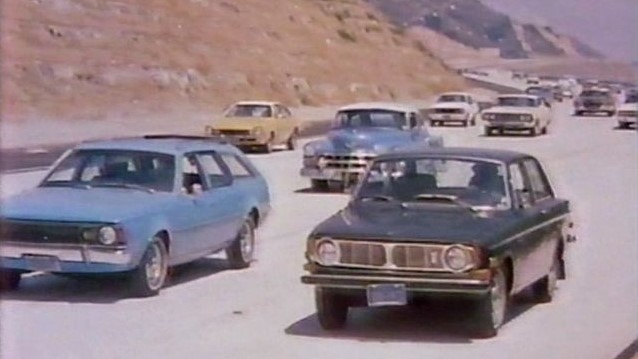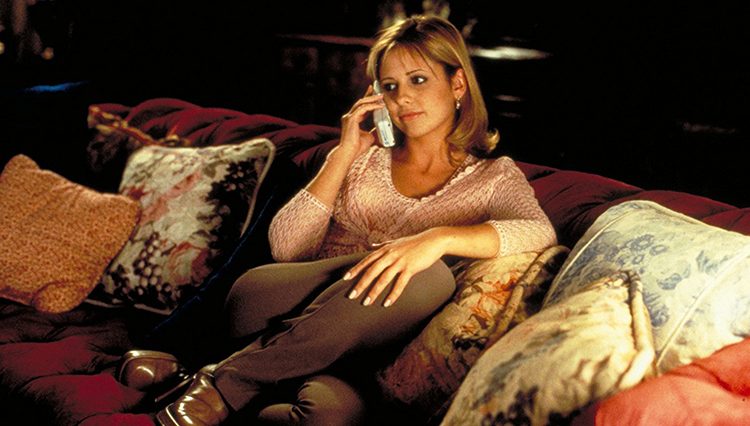
15 Lives Bound Forever in One Shattering Second … The Most Awesome Automobile Accident Ever Filmed!
Disaster films were something of a staple in the 1970s, beginning with 1970’s Airport, followed soon by The Poseidon Adventure (1972), The Towering Inferno, Earthquake (both 1974) and a host of imitators. ABC soon caught onto this trend, incorporating it into their ABC Movie of the Week format. 1972’s Short Walk to Daylight featured an earthquake hitting New York City and survivors of a subway tunnel collapse have to find their way out. Then there was Runaway! in 1973 with a runaway train threatening a ski resort. Skyway to Death repeated this with an aerial tram, The Elevator gave us a group of people trapped in a high-rise elevator…you get the idea.
Although they had officially ended the Movie of the Week, ABC and the other networks were still delivering made-for-TV movies intended to provide at-home competition, sometimes programmed on Friday or Saturday night for those staying home and not venturing out to see Rocky or Network. This is one such telefilm.
Airing December 3, 1976, on ABC at 9 pm/8 central was…Smash-Up on Interstate 5!

Loosely based on the novel Expressway written by Trevor Dudley-Smith, one of the many pseudonyms of British novelist Elleston Trevor, Smash-Up told the story of an enormous multi-vehicle collision on California’s Interstate 5 one July 4th weekend. In typical disaster movie style, the ‘disaster’ is simply a framing device used to tell stories from the lives of several groups of characters who all intersect at the titular event.
Shortly after the telefilm opens, a voiceover tells of the massive Sunday morning July 4 highway multicar pile-up involving 39 vehicles. We are informed that 14 people are killed and 62 are injured. The story then shifts to 43 hours earlier to tell the narratives of those involved in the smash-up leading up to the event.
- Robert Conrad’s CHP Sergeant Sam Marcum briefs his squad to prepare them for the upcoming holiday weekend. Marcum’s lady was Laureen (Donna Mills), a nurse at the hospital working the holiday weekend.
- Buddy Ebsen and Harriet Nelson were Al and June Pearson, longtime couple loving each other in their golden years, but June’s heart condition means their time together is limited.
- Tommy Lee Jones was CHP officer Jimmy Hutton on patrol that day with pregnant wife Barbara (Sian Barbara Allen) at the hospital about to pop anytime.
- George O’Hanlon Jr and Terry Moore were Pete and Trudy, a young criminal couple that held up a store and hijacked Lee Bassett (Scott Jacoby), on parole himself-but now gets to play getaway driver.
- David Groh was good-guy truck driver Dale who saves the older Erica (Vera Miles) from a motorcycle gang beginning to sexually assault(!) her in broad daylight and he quickly falls for her.
- Joel Parks and Sue Lyon are Andy and Burnsey, trashy counterculture motorcyclist couple involved in the assault on Erica; now on their way to meet the rest of the gang in San Diego.
All their stories lead to them being on I-5 on the fateful early Sunday when the disastrous collision happened. Our entry point into the titular crash is when a line of CHP units and helicopter are in pursuit of Lee and Trudy, now a Bonnie and Clyde couple, speeding down I-5 in a literal X-rated ‘sin van,’ although this is not the cause of the crash.

If you think I’ve given out too much of the plot, there is plenty that I didn’t divulge should you watch the film. The TV movie was well received, making the top 10 programs that week in the Nielsen ratings. Viewers other choices for the evening of December 3 were the 1974 George Segal sci-fi film The Terminal Man playing on the CBS Friday Night at the Movies, or the Hallmark Hall of Fame presentation of Beauty and the Beast starring George C. Scott and wife Trish Van Devere over on NBC.
Interestingly, the telefilm frames the smash-up around the duties as well as personal lives of the California Highway Patrol while presenting the massive collision as sort of a pseudo-educational traffic safety scare film. Smash-Up pre-dates the 1970s iconic series CHiPs by nearly a full year and is remarkably similar to how CHiPs episodes were structured, albeit without the exciting disco beat. You must wonder if the success of Smash-Up had any influence on the development or greenlighting of the NBC series created by Rick Rosner, then VP of Variety Programming at NBC.
Probably my biggest criticism of the telefilm is that the ending is anti-climactic, having already shown the titular smash-up at the beginning, and the abrupt ending once it is shown again. Characters die (we presume) in the crash, but not enough time is spent on each one for there to be any real emotional impact and the fate of some characters is ambiguous. Without seeing a script, it’s hard to know if this was the fault of the writing or if something was left on the editing room floor. However, showing the enormous crash at the beginning likely kept the attention of youngsters whose bedtime surely arrived before the telefilm ended at 11 pm/10 central.
But those youngsters likely weren’t overly impressed with the cast, peppered with several very familiar names to mom and dad. Screen actress Vera Miles, TV legend Harriet Nelson, and the prolific Buddy Ebsen taking a break from his weekly duties over at Barnaby Jones were among the cast. At least some of the casting was also a family affair, as we saw Nelson’s son David and Ebsen’s daughter Bonnie also appear in the telefilm.
Harriet Nelson’s involvement came at the prompting of her friend Carol Jones who happened to be the casting director for Smash-Up. Mrs. Nelson had suffered the loss of her husband Ozzie a year prior and had not worked since. If any readers are unfamiliar, the Nelsons were that all-American family in The Adventures of Ozzie and Harriet for the generation that grew up watching TV in the 50s and 60s, as the series ran an incredible 14 years. When sons David and Ricky were consulted, Harriet commented, “They were just delighted. I think they were more excited about it than I was. They wanted so much for me to go back to work, I think because they knew what it would do for me.”

While it may seem dated now to a jaded audience raised on $200 million films where we can see 150 cars destroy each other on a post-apocalyptic Earth, this was perfectly good Friday night entertainment for homebodies in 1976. This was also the pre-VCR rental era and you typically had three channels of entertainment to choose from. Made for TV movies like this were a big draw in that era. Also, keep in mind this was done on a TV budget.
Smash-Up was directed by the accomplished John Llewellyn Moxey, who brought us hundreds of hours of television including TVMs The Night Stalker, Genesis II, and Escape (a Christopher George vehicle which somehow later became The Magician with Bill Bixby-I’ll have to unravel that little tale another time.)
With the central event of the telefilm being a massive car crash, much responsibility rested on the stunt coordinator Charles Picerni and his crew of a dozen stunt drivers and dozens of extras that knew their way around stunt work. Even though the storyline indicated 39 vehicles were involved, the actual crash choreographed on I-210 involved 28 cars, two weeks of prep work, and three days of filming. Picerni was the stunt coordinator for Mannix, Kojak, and Starsky and Hutch-and would work stunts on every action-heavy TV show in the 80s.
Picerni took much more of a specialized approach for this telefilm than the average episode of Starsky and Hutch, as he told Vernon Scott for a period UPI article. “The stunt coordinator has to know as much about the characters as the director…the key cars-carrying the leading actors-are highly identifiable. For instance, Buddy Ebsen and Harriet Nelson are in a Cadillac. Vera Miles is in a Fiat. Sue Lyon is riding a motorcycle. David Groh is driving a semi-truck and Bob Conrad is driving a police car.”
Picerni left out the 1961 Ford E-100 ‘sin van’ tricked out with boudoir in the rear. The age of the van and other running vehicles were a result of the TV budget he was given to work with. Full roll cages were installed on Ebsen’s ’53 Cadillac Coupe DeVille and the Ford van since both vehicles were required to overturn during the stunt sequences. The vehicles had only a quart or two of gasoline in the tanks to avoid explosions and out-of-control fires. Fire trucks and extinguishers were on hand, as well as an ambulance in the event anything went wrong. Each collision was filmed with three or four cameras as there were no retakes. As Picerni said, “once the car is wrecked you can’t put it together again.”
The real Interstate 5 is a north/south highway on California’s west coast that stretches from Canada to Mexico. Standing in for I-5 was I-210, an east-west freeway running through the valleys north and east of Los Angeles. A portion that was under construction and not yet open for traffic near La Crescenta, California was used. This same stretch of highway was later used for 1978’s Corvette Summer.


Smash-Up on Interstate 5 was rerun on ABC the following year, popped up on cable and local stations throughout the 1980s and 90s, and received a VHS release. Today, it can be watched at your convenience on YouTube.
Forgotten TV Movies is a column that will regularly consider made-for-TV movies of the 70s/80s of various genres. Oh, the places we’ll go and the sights we’ll see.




